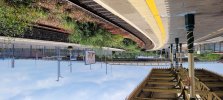It is worth asking what degree of vegetation control is economically rational from the rail infrastructure operators perspective and this probably gives a good indication of why our railway linesides look much less 'neat' compared to photographs from the steam age.
The benefits of vegetation management include reducing the likelihood of some disruptions, such as those caused by falling trees or low adhesion or by more indirect impacts such as speed restrictions where there is a chance of these. It also reduces the costs of other maintenance activities, for example if you preserve the drainage on ballast it will last longer. It avoids damage to structures (think buddleia growing out of viaducts) and lastly, it mitigates some hazards, such as collision with branches or critical safety signage being obstructed. A generally tidy appearance may be valued by potential passengers, which may in turn have a small impact on their willingness to travel and thus buy tickets (although I expect this marginal value is very small).
Set against this are the costs, like all track side activities, the staff used are highly regulated and expensively trained and need to use specialist equipment and highly regulated substances in addition to cheap, basic tools. Because almost every time they can work effectively, the railway cannot earn revenue, they are also highly unproductive and inefficient (in the sense that they will have quite a bit more paid time than actual task time) and must often be paid extra for working at unsocial hours. They are part of a function that necessarily has a high planning overhead to squeeze the necessary work into the available short and infrequent windows likely determined by the schedules of completely unrelated maintenance or engineering activities.
I would suggest that the factors are what bring us to 'revealed' preference of Network Rail: they have determined the most cost effective strategy is the minimum necessary ad-hoc reactive maintenance dealing with specific vegetation incidents that arise together with very infrequent 'blitz' style management, where basically everything is cut to ground level including any trees and shrubs using a fairly large team and some significant equipment - which once completed are left for the next decade or so. As a Welwyn Garden City to London commuter I can see a fair amount of this has taken place in the last few years, so I guess this happens every 10-20 years in any given priority location. I suspect that less is done on less busy and slower speed corridors. Incidentally, a downside of this strategy is that it is not liked by lineside residents as a noise barrier that has grown up over many years, suddenly gets removed.
I very much doubt we will ever see a return to a more intensive 'steam age' high staffing model of trackside maintenance. Lineside vegetation management remains a very labour intensive, low productivity task and people are very expensive. Incidentally, I used to have a lovely buddleia at the bottom of my garden (not a railway

), which was very good for summer butterflies, but it did not survive being repeatedly cut to a stump one of the children's grand parents against my recommendation...

